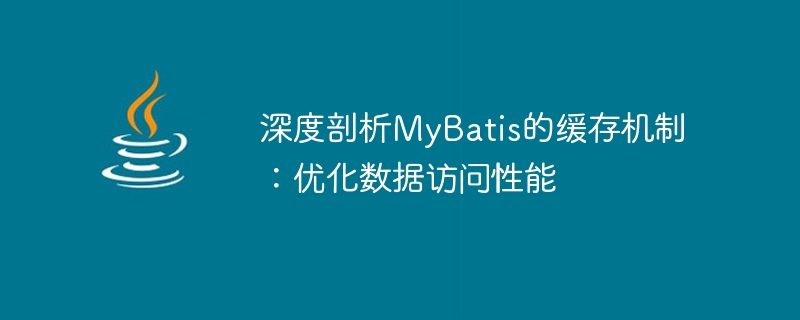

MyBatis is a popular persistence layer framework, and its powerful caching mechanism plays an important role in optimizing data access performance. This article will deeply analyze the caching mechanism of MyBatis, discuss how to use caching to improve system performance in actual development, and provide specific code examples.
The caching mechanism of MyBatis is mainly divided into two types: first-level cache and second-level cache. The first-level cache is a SqlSession-level cache, stored inside the SqlSession, and its scope is data sharing within the same SqlSession object. The second-level cache is a Mapper-level cache, and its scope is data sharing between different SqlSession of the same Mapper.
// 获取SqlSessionFactory对象
SqlSessionFactory sqlSessionFactory = MyBatisUtil.getSqlSessionFactory();
// 开启一个SqlSession
SqlSession sqlSession = sqlSessionFactory.openSession();
try {
// 获取Mapper接口
UserMapper userMapper = sqlSession.getMapper(UserMapper.class);
// 第一次查询,会发送SQL语句到数据库查询数据
User user1 = userMapper.selectUserById(1);
// 第二次查询,由于缓存命中,不会发送SQL语句,直接返回缓存数据
User user2 = userMapper.selectUserById(1);
System.out.println(user1 == user2); // 输出true
} finally {
sqlSession.close();
}First, enable the second-level cache in the MyBatis configuration file:
<settings>
<setting name="cacheEnabled" value="true"/>
</settings>Then, set the cache in the mapping file of the Mapper interface:
<mapper namespace="com.example.UserMapper">
<cache/>
<select id="selectUserById" resultType="com.example.User">
select * from user where id = #{id}
</select>
</mapper>Then, use the second-level cache in the code:
// 开启第一个SqlSession并执行查询 SqlSession sqlSession1 = sqlSessionFactory.openSession(); UserMapper userMapper1 = sqlSession1.getMapper(UserMapper.class); User user1 = userMapper1.selectUserById(1); sqlSession1.close(); // 开启第二个SqlSession并执行查询 SqlSession sqlSession2 = sqlSessionFactory.openSession(); UserMapper userMapper2 = sqlSession2.getMapper(UserMapper.class); User user2 = userMapper2.selectUserById(1); sqlSession2.close(); System.out.println(user1 == user2); // 输出true
When dealing with the database When performing an update operation, MyBatis will automatically invalidate the cache according to the configured cache policy. The cache can be cleared manually in the mapping file:
userMapper.insertUser(new User(2, "Alice")); sqlSession.clearCache(); // 清空缓存 User user3 = userMapper.selectUserById(2); // 重新查询,触发缓存更新
Through the in-depth analysis of this article, we understand the caching mechanism of MyBatis and illustrate it through specific code examples. How to use the first-level cache and the second-level cache. Reasonable use of MyBatis' caching mechanism can effectively improve the system's data access performance and reduce frequent access to the database, which is an important means to optimize system performance. We hope that through the guidance of this article, readers can flexibly use MyBatis' caching mechanism in actual projects and contribute to improving system performance.
The above is the detailed content of In-depth discussion of MyBatis' caching mechanism: improving data access efficiency. For more information, please follow other related articles on the PHP Chinese website!
 what is optimization
what is optimization
 mybatis first level cache and second level cache
mybatis first level cache and second level cache
 Baidu keyword optimization software
Baidu keyword optimization software
 SQL statement to backup database
SQL statement to backup database
 Baidu SEO keyword ranking optimization method
Baidu SEO keyword ranking optimization method
 What is the difference between ibatis and mybatis
What is the difference between ibatis and mybatis
 How to configure database connection in mybatis
How to configure database connection in mybatis
 What is the working principle and process of mybatis
What is the working principle and process of mybatis




